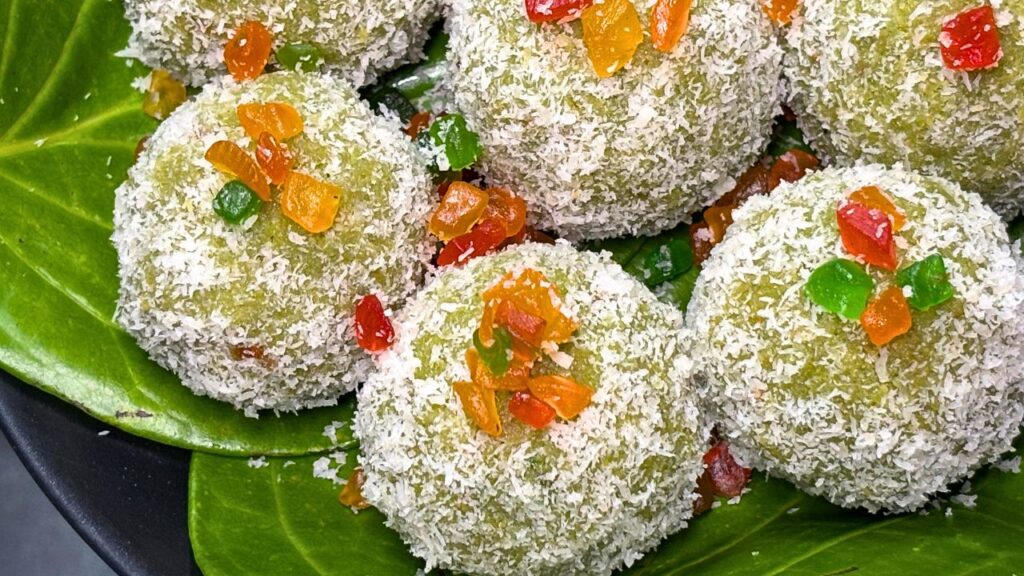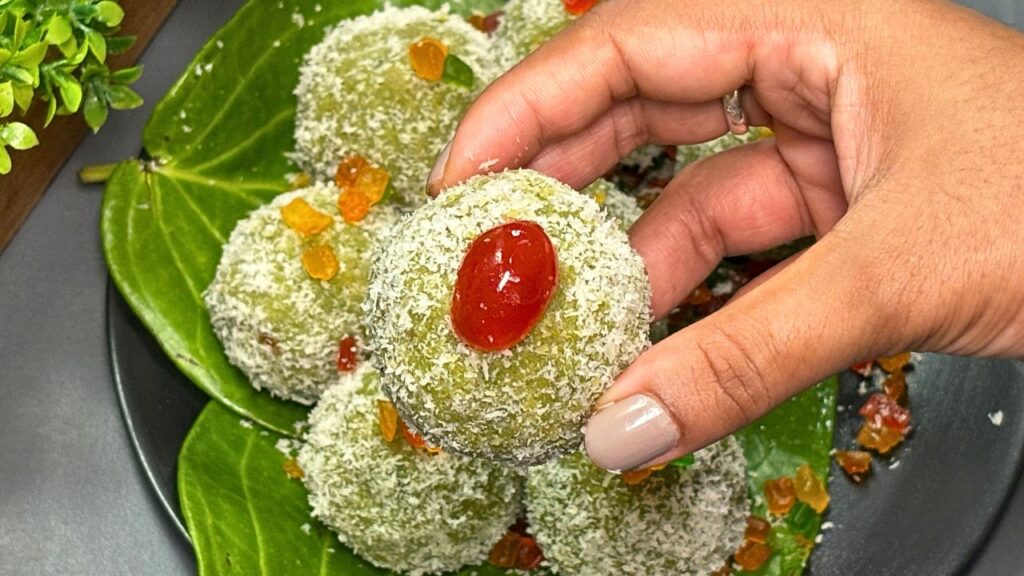



The Paan Laddu is a delectable Indian dessert combining the refreshing taste of betel leaves (paan) with the richness of condensed milk and the sweetness of gulkand (a rose petal preserve). This sweet treat is a variation of the traditional coconut laddu but with a twist of paan flavor. Paan Laddu, a popular Indian sweet recipe, is perfect for festive occasions and can easily be prepared at home. It’s a unique blend of ingredients like desiccated coconut, gulkand, and betel leaves, which makes it an enticing option for anyone who enjoys Indian sweets. The combination of betel leaves with coconut and condensed milk brings a refreshing and aromatic taste that sets this laddu recipe apart from other traditional Indian sweets.

Indian cuisine is renowned for its wide variety of sweets, each with its distinct flavor, history, and cultural significance. This Laddu is one such creation that blends the aromatic flavor of betel leaves with the familiar, comforting taste of coconut laddu. This laddu recipe appeals not only because of its flavor but also for its unique green color and chewy texture. Made with ingredients such as condensed milk, fennel seeds, and cardamom, this sweet recipe is a simple yet elegant way to impress your guests during festivals or family gatherings.
The Laddu’s distinct flavor profile makes it an excellent choice for those seeking something different in Indian sweets. The usage of betel leaves in this laddu recipe is inspired by traditional Indian paan, which is often enjoyed as a mouth freshener after meals. The recipe combines the sweetness of gulkand and the mild spiciness of fennel seeds, giving it an authentic flavor reminiscent of traditional paan. Additionally, these laddus are packed with the goodness of coconut, making them a great source of healthy fats and energy.
When it comes to making sweets at home, the Paan Laddu is a great choice because it is simple to prepare and does not require many complex ingredients. The recipe calls for a few basic pantry items, making it an accessible option for any cooking enthusiast. Moreover, the Laddu provides a creative and fun way to use betel leaves, offering a refreshing change from the typical Indian sweets. This coconut-based laddu recipe is ideal for celebrations like Diwali, weddings, or any festive occasion where an elegant and delicious dessert is desired.
Beyond its delightful taste, this Laddu is a relatively healthy choice among traditional Indian sweets. Since it uses coconut, which is rich in medium-chain triglycerides (MCTs) and dietary fiber, this sweet provides a quick energy boost and keeps you full for longer. Additionally, the fennel seeds and betel leaves used in this recipe aid in digestion, while the gulkand adds a natural sweetness that’s packed with antioxidants. This combination of taste and health benefits makes it an attractive addition to any festive menu.
To prepare this Laddu, the key ingredients include betel leaves, desiccated coconut, condensed milk, fennel seeds, gulkand, tutti frutti, and cashew nuts. The betel leaves are first blended with condensed milk and fennel seeds to create a smooth, aromatic puree. This puree is then added to roasted desiccated coconut to form a soft mixture, which serves as the base for the laddus. To give the laddus a sweet and refreshing center, a filling of gulkand, tutti frutti, cashew nuts, and cardamom is prepared and stuffed into each laddu.
The preparation process is quite simple and can be done in a short period. Once the coconut mixture is ready, you create small cups or katoris with the mixture and fill them with the gulkand stuffing. Each filled katori is then rolled into a ball and coated with more desiccated coconut. The result is a visually appealing green laddu with a sweet and flavorful center.
While Paan Laddu is traditionally made with gulkand and coconut, there are many variations you can try based on your preferences. For instance, you can add dry fruits like almonds, pistachios, or raisins to the filling for a richer texture. Alternatively, using jaggery instead of condensed milk can make the laddus more wholesome and reduce the refined sugar content. This versatility makes this Laddu recipe a perfect starting point for those looking to create their own unique version of this sweet treat.
From a health perspective, this sweet provides several benefits. Betel leaves are known for their digestive properties, while fennel seeds help in relieving bloating and improving digestion. Coconut, which forms the base of these laddus, is an excellent source of healthy fats, fiber, and minerals like manganese and copper. Furthermore, gulkand has cooling properties and is rich in antioxidants, making these laddus a refreshing and healthy dessert choice.

Paan Laddu is a delightful and innovative dessert that merges the traditional flavors of paan with the familiar taste of coconut laddus. This simple yet impressive laddu recipe can be prepared in no time, making it a perfect addition to your festive sweet platter. With its visually appealing green color, sweet and aromatic center, and refreshing flavor, this Indian sweet is sure to be a hit among your family and friends.
Whether you are a fan of coconut-based sweets or looking to try something new, this Laddu offers a unique combination of flavors that will leave you craving more. So, why not give this recipe a try and impress your guests with a creative and refreshing twist on traditional Indian sweets? It’s a must-try laddu recipe for anyone who enjoys experimenting with flavors and making elegant sweets at home.
In a mixer jar, combine 5 betel leaves, ½ cup of condensed milk, and ¼ teaspoon of fennel seeds. Grind the ingredients to a smooth paste and set it aside. This puree will give the laddus a distinctive paan flavor and a smooth consistency.
In a mixing bowl, combine 2 tablespoons of gulkand, 2 tablespoons of tutti frutti, 1 tablespoon of chopped cashew nuts, and ¼ teaspoon of cardamom powder. Mix well to form a flavorful and aromatic filling. Set this aside for later use.
Heat a pan over low flame and add 1 tablespoon of ghee along with ½ cup of desiccated coconut. Roast the coconut lightly for about 2-3 minutes, ensuring it doesn’t burn. Once roasted, add the betel leaf puree you prepared earlier. Mix well and turn off the flame, allowing the mixture to cook with the residual heat for 2-3 minutes or until all ingredients are well combined. Allow this mixture to cool slightly.
Once the mixture is cool enough to handle, take a small portion of the coconut-betel mixture and flatten it in your palm to form a small cup or katori shape. Place ½ tablespoon of the prepared gulkand filling inside this katori and then cover it with another small portion of the coconut mixture. Gently roll the entire portion into a round laddu.
Roll each laddu in the remaining desiccated coconut until it is evenly coated, giving it a delightful outer texture. Repeat the process with the remaining mixture and filling until all laddus are formed.
Decorate the prepared laddus with a small piece of cherry or tutti frutti on top for an extra pop of color and sweetness. Enjoy these flavorful Paan Laddus, a perfect blend of coconut, gulkand, and betel leaves!